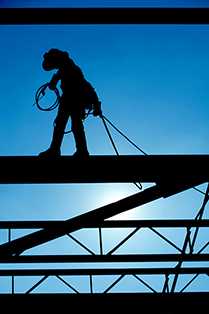Program Goals

A key leadership role for the Construction Program is the development of goals for construction. The Construction Program is in the process of developing goals to guide NIOSH research and partnership efforts over the next decade. Two priority areas that will continue are falls and green construction.
NIOSH Program Portfolio Approach
NIOSH organizes its research, guidance, information, and service efforts into specific programs that can be readily communicated and strategically governed and evaluated. Ten sector programs represent industrial sectors, and seven Cross-sector Programs are organized around health and safety outcomes. There are also numerous core and specialty programs that represent special emphasis areas, methodological approaches, core activities and legislatively mandated programs.
The Sector Programs intersect with cross-sector programs in a matrix-like fashion, with relevant core and specialty programs playing a supporting role. For example, an Agriculture, Forestry and Fishing Program goal of reducing farm-related deaths and injuries due to tractor rollovers and trucks would likely be a shared goal with the Traumatic Injury Prevention Program and if appropriate would be adopted by both programs. This approach provides an added advantage and will allow multiple Programs to work towards accomplishment of intersecting NIOSH goals.
Below are the current active goals developed during the second decade of the National Occupational Research Agenda (NORA).
Construction Program Strategic Goals for Intramural Research
- Strategic Goal 1: Reduce Construction Worker fatalities and serious injuries caused by falls to a lower level.
- Strategic Goal 3: Reduce fatal and serious injuries associated with struck-by incidents associated with objects, vehicles, and collapsing materials and structures.
- Strategic Goal 4: Reduce hearing loss among construction workers by increased use of noise reduction solutions, practices, and hearing conservation programs by the construction community.
- Strategic Goal 5: Reduce silica exposures and future silica –related health risks among construction workers by increasing the availability and use of silica dust controls and practices for tasks associated with important exposures.
- Strategic Goal 6: Reduce welding fume exposures and future related health risks among construction workers by increasing the availability and use of welding fume controls and practices for welding tasks.
- Strategic Goal 7: Reduce the incidence and severity of work-related musculoskeletal disorders among construction workers in the U.S.
- Strategic Goal 8: Increase understanding of factors that comprise both positive and negative construction safety and health cultures; and, expand the availability and use of effective interventions to maintain safe work practices 100% of the time in the construction industry.
- Strategic Goal 9: Improve the effectiveness of safety and health management programs in construction and increase their use in the industry.
- Strategic Goal 11: Develop and build recognition and awareness of construction hazards and the means for controlling them by strengthening and extending the reach of quality training and education in the construction industry, including non-English speaking workers.
- Strategic Goal 12: Reduce injury and illness among groups of construction workers through improved understanding of why groups of workers experience disproportionate risks in construction work and expanding the availability and use of effective interventions.
- Strategic Goal 13: Increase the use of “prevention through design (PtD)” approaches to prevent or reduce safety and health hazards in construction.
- Strategic Goal 14: Improve surveillance at the Federal, State, and private level to support the identification of hazards and associated illnesses and injuries; the evaluation of intervention and organizational program effectiveness; and the identification of emerging health and safety priorities in construction.
- Strategic Goal 15: Engage the media more effectively to raise awareness and improve safety and health in construction.
Construction Program Priority Strategic Goals for NIOSH-funded Extramural Research
The NIOSH Construction Program selected the following strategic goals as particularly suited for extramural research during fiscal year 2017:
- Strategic Goal 1: Reduce Construction Worker fatalities and serious injuries caused by falls to a lower level.
- Strategic Goal 3: Reduce fatal and serious injuries associated with struck-by incidents associated with objects, vehicles, and collapsing materials and structures.
- Strategic Goal 5: Reduce silica exposures and future silica-related health risks among construction workers by increasing the availability and use of silica dust controls and practices for tasks associated with important exposures.
- Strategic Goal 7: Reduce the incidence and severity of work-related musculoskeletal disorders among construction workers in the U.S.
- Strategic Goal 8: Increase understanding of factors that comprise both positive and negative construction safety and health cultures; and, expand the availability and use of effective interventions to maintain safe work practices 100% of the time in the construction industry.
- Strategic Goal 12: Reduce injury and illness among groups of construction workers through improved understanding of why groups of workers experience disproportionate risks in construction work and expanding the availability and use of effective interventions.
- Strategic Goal 13: Increase the use of “prevention through design (PtD)” approaches to prevent or reduce safety and health hazards in construction.
Those seeking NIOSH grants to conduct studies related to the Construction Program are invited to view the current funding opportunities
- Page last reviewed: January 13, 2017
- Page last updated: January 13, 2017
- Content source:
- National Institute for Occupational Safety and Health Office of the Director


 ShareCompartir
ShareCompartir